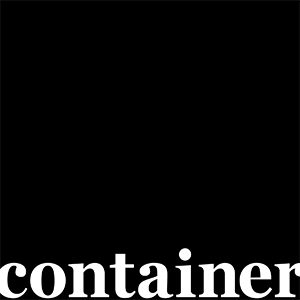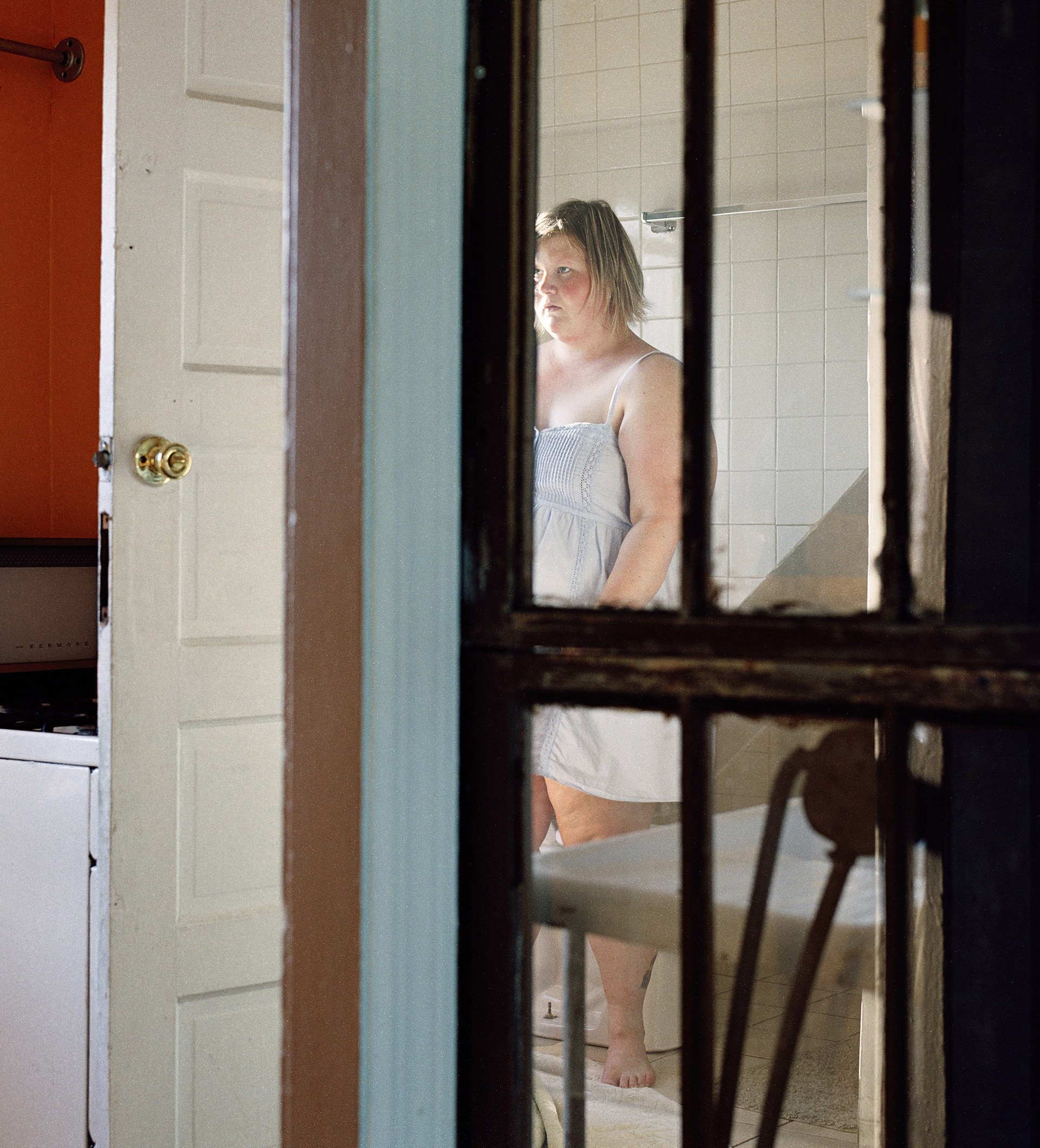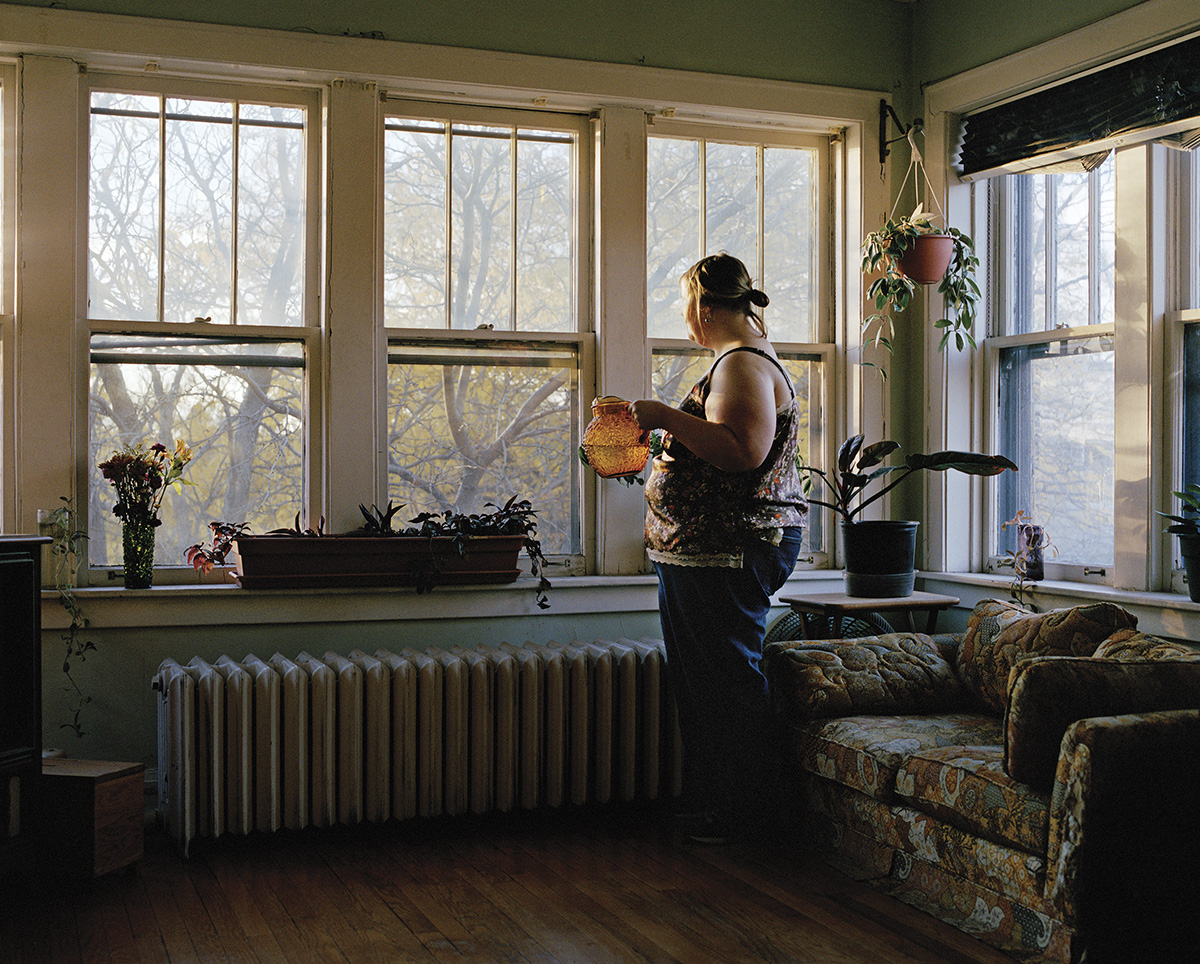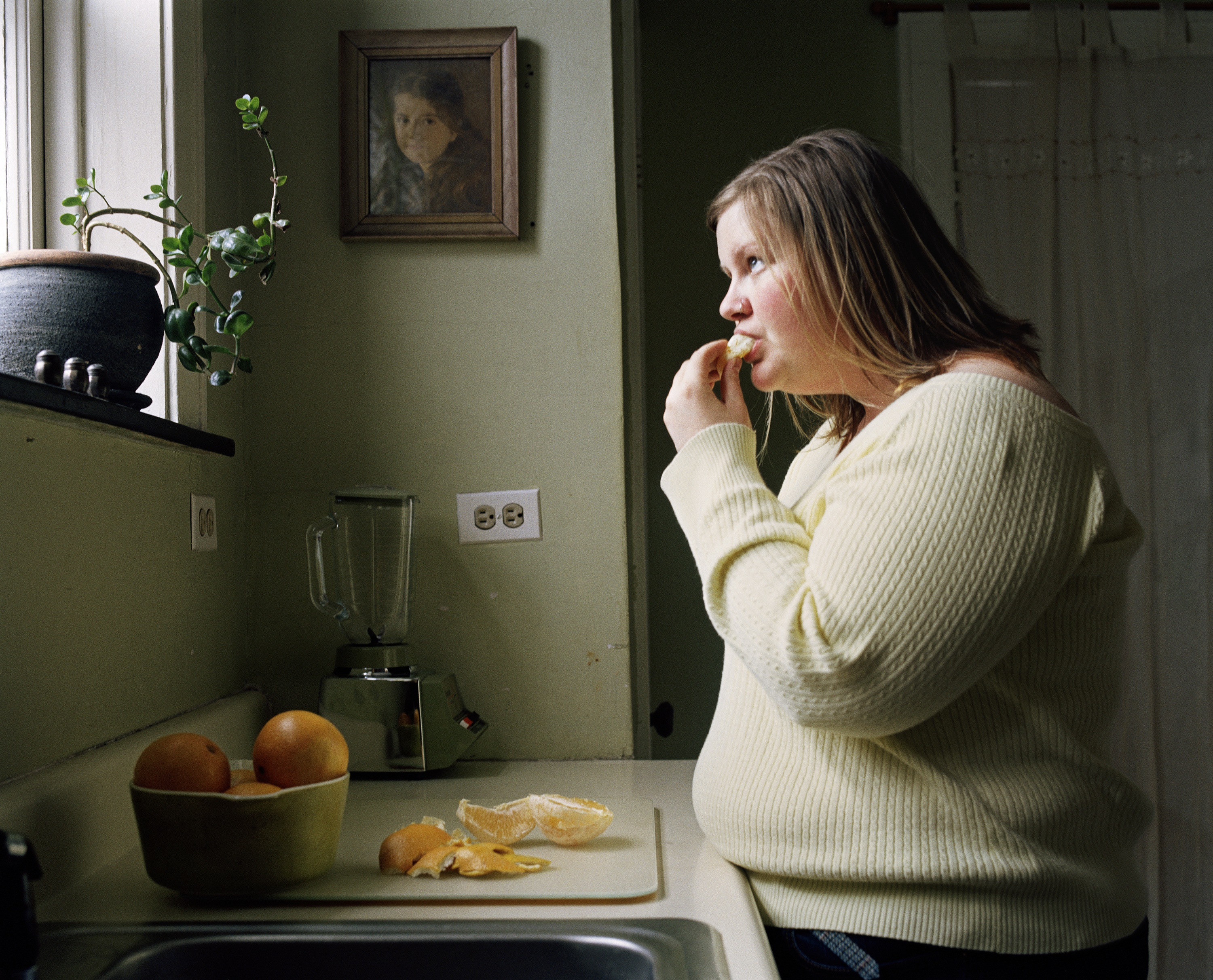I
n 2002 photographer Jen Davis began a decade-long series of self-portraiture exploring beauty and the body in relation to the interior. The culmination of this project resulted in a monograph and her first solo show in New York – entitled Eleven Years – at ClampArt in the Summer of 2014.
Throughout the series, Davis employs interior architecture as a means of investigating the private and public self. In “Untitled No. 4,” Davis is seen through the building studs of an unfinished interior room. Her body, caged by framing lumber, creates a sense a remoteness that is reflected in her expression. In “Obstruction,” a window frame blocks out Davis’ face. Her identity is obscured, reducing her body to another element within the architecture. In this series, the interior is not always at odds with the body. A green hued bedroom takes on a Vermeer-like quality with Davis as the central figure bathed in a warm light that turns her pale skin a lovely shade of pink.
Not only does light provide universal depth to an image, it connects the external public world to Davis’ internal private world. In “Untitled No. 55,” light enters an otherwise dark room through an unseen window. Davis’ eyes are shut as her body melts into the background; she is caught in a vulnerable moment. As the viewer we are allowed access to this scene, as is the band of light that penetrates this interior space.
This summer I sat down with Jen Davis to talk about the culmination of Eleven Years and her ideas about light, color, and the interior.
Your self-portraits are made primarily in domestic interiors. When you first develop an idea for a photograph, to what degree do you consider interior space?
I think most times the location informs the picture. I don’t draft anything or create a completely new environment. It’s mostly about using what’s available and what I see. Also, it’s about the light that enters into the space. In fact, the light is what guides the photograph; it creates a set, in a way. And I’m using natural light. Artificial light is different, of course, but the natural light is like another character within itself that comes and enters into the space.
There is a photograph I made that was early on when I was living in Chicago. It was a third floor apartment surrounded by two-story buildings, so there was nothing obstructing our windows. I don’t even think I was thinking about light then, at least not so coherently. But I came home and opened the door and there was the most amazing light in the living room and on the kitchen table. And I thought, I have to make a photograph here.
So the photographs are informed by the space?
I think they’re informed by the light more so than the space. For example, I’m thinking about a specific photograph where I’m watering plants. It’s a very banal thing, a woman in her apartment watering plants. But the darkness of the room, the 4 o’clock light coming in, it heightens the tension and psychological drama of the scene.
That photograph was very intuitive for me to make. I put on a shirt that matched the pattern of the couch and there was something interesting that I saw when I was making the photograph with the scale of the couch, how it’s very small versus the body, that went with that matching pattern.
Yes! Not only is there the drama of the light, but also a heightened sense of isolation with you inside looking out.
Exactly. I shot film but I scanned the negative and [in doing so] you get all the information in the highlights that are lost in the c-print. Because of that there is all this information in the window of the picture – you can see the tree branches and it looks like veins. It’s like the interior self is reflected in the exterior, which also adds a different kind of interpretation.
It’s interesting to hear that you would change outfits to match your interior. Do you commonly attempt to connect yourself to the interior in that way?
Yeah. I think the palette was always something I was interested in, or searching for. For example, the color of the apartment that the earlier pictures were taken in was a shade of green I was really drawn to, and I painted one of the rooms blue because I liked it. I would purchase clothes at a thrift store thinking about a photograph that could be made in that space. But it was also about perceiving beauty as something that could be based on color and light. Something that’s not conventionally seen as beautiful, like this person, or this body, and trying to shed a beauty onto it. Trying to seduce with color and light.
When you turned the camera on yourself and began your portrait series, did you start out thinking, “I want to photograph interiors?” Was there a conscious decision to shoot yourself in a domestic environment instead of a studio environment?
I think it was just something I responded to: the isolation of this home and domestic space. Maybe because it was my first apartment, when you’re just kind of figuring out your home and what that means. But there was something about being indoors, an emotional interior space that I was interested in, and the idea of the home. I think later on when I began to craft the pictures there was more of a placement on home and making it my own. Like identifying with it or having some kind of individuality with it. But I think I chose to stay inside. Some of my photos take place outside, but for the most part, it’s about channeling or challenging this interior sense of self or privacy. It’s a kind of push and pull between the private and the public. I was doing things for the camera that were really hard or embarrassing, and that was an act of release for me.
As viewers we are granted entry into this private world, and by not always confronting the camera you support that.
The camera is, for the most part, very observational; I’m rarely ever confronting it. And, that’s something I didn’t realize in the beginning. It was just like a third set of eyes or third party. There wasn’t much of a relationship to it, it would just absorb. The camera records what it sees, it’s like the dead honest truth of me. Or seeing me in a way I could never see myself. It doesn’t lie or withhold anything, and it’s not about flattery. So there’s this replica of me that’s transpired on the film.
What are you thinking about when you sit in front of the camera? Do you go into character?
I don’t think it’s necessarily a character, but a lot of times the work is really performative: it’s a side of me where I’m able to ask questions to the camera. It’s this kind of empowerment. When I’m taking the picture there is a point where I shut off. I’m in the moment, feeling the light, feeling the breeze. In every photograph I’ve taken, those moments of making them are all the memories I have. I can remember what the light felt like on my body, the wind on my skin with the window open, or the painful thing that was happening emotionally in the set that I was like trying to convey. Because some of them were very intuitive, like in the moment of what I was experiencing. And those are the harder ones for me to think of, or maybe the harder ones for me to make at the time.
I want to touch on your series, “I Ask in Exchange,” because you capture a similar connection between the body and space. When you were making portraits of men, was it important to place them in the domestic environment as well?
Yes, and it was also important for me to be present in their space. I’m very grateful that these people allowed me into their world and allowed me to watch them in these private, intimate moments. More is suggested in those moments then what actually took place, but that fiction works and it’s what I’m interested in.
Could you talk more about the creative process of working with these men? I imagine it was a different experience than photographing yourself.
It’s all about making decisions at the time and in the space. I go into it and it’s new to me, and it’s just making decisions. Like the guy rubbing his chest with the red bedspread, I put him there because the light was nice. Pictorially it was really beautiful and I responded to that. But with the self-portraits, if the light wasn’t right or if I missed it, I could look at it and come back the next day. I could have an idea, have the camera set up, and wait for everything to be lined up and everything to be perfect, and then make the picture.
Would you be arranging things? Like folding sheets back or messing up the bed?
Oh yeah, I would definitely arrange things. The one of the couple on the bed with the sheets, that was from their bodies as they rolled around, but I would definitely go into a space and move things around in other scenarios.
What are you looking for when you’re arranging things?
I think I’m just trying to make it neat, to take away the clutter, or just make a better frame. And I will add things – like in the self-portraits there were details and things I would add. There’s a picture of me eating oranges with a painting behind me. I put the painting there and arranged the three shakers. There’s also a curtain up behind me to eliminate the chaos in the other room. It was a pictorial decision I made when making the picture.
When you put the painting of the girl up, were you thinking about the gaze? She’s looking at the viewer, the viewer is looking at you and you are looking away. It makes for a very voyeuristic experience.
I don’t know if I was thinking about the gaze necessarily, but I was definitely thinking about the presence of the painting of the young girl and identifying with her. Those are my roommates and there was a young boy and a young girl and I chose the girl to put there. So there was definitely this younger figure I was interested in. And, I think there was something about the light of that painting, the kind of Dutch soft northern light. With that picture I set up the camera the night before and then I woke up at 7 or 8am and made the picture. The curtain was up, everything was in place, I pre-visualized it and then made it the next day.
Now that you finished the series are you going to continue making self-portraits?
I don’t know. I’ve made pictures recently but I haven’t scanned them or done anything with them. The last picture for the book was more about giving myself a deadline and not being able to add anything. But I’m really not that engaged with looking at myself at this point. I think it’s something I’ll come back to, but I feel this pressure to do something else. This also feels like closure, with the book and the show it feels like an ending. I think, though, there is something in me that wants to come back to it. I don’t think I’ll never photograph myself again. If it feels important or if there’s something happening in my life that it feels necessary to. But I want to challenge myself and do other projects.
What other projects do you have planned?
I want to photograph women right now. It’s something I’ve never really done. I’m interested in going to LA and making pictures of women there. I’ve never been to Los Angeles, I want to go someplace I don’t know, that’s foreign to me and that’s also very surface level. I want to get under that surface, look at the beauty, the body. Like beaches, pageants, teenagers, I don’t know, but just to see what comes from it. It’s exciting to me because I’m interested in this process of letting the people I meet inform where the work will go. When I started the “I Ask in Exchange” project, that started with a road trip I went on and one photograph worked from there. That one photograph propelled the project. So, I’m looking for inspiration right now. How it will be shaped is a big question mark still. Which is exciting and fun. And it could totally fail and flop and not be interesting and I could hate it. But that’s the process of working, you know?
More of Jen Davis’s work including Self-Portraits and I Ask in Exchange can be found on her website. She is represented by Lee Marks Fine Art and lives in Brooklyn.
JENNIFER JUNE
This interview has been edited for length and clarity.
PLATES
1 (Feature) Jen Davis, “Untitled No. 11,” from the series Eleven Years
2 Jen Davis, “Untitled No. 15,” from the series Eleven Years
3 Jen Davis, “Sean,” from the series I Ask In Exchange
4 Jen Davis, “Gift from Grandpa,” from the series Eleven Years




